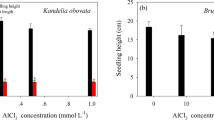Abstract
Agriophyllum squarrosum is an annual desert plant widely distributed on mobile and semi-mobile dunes in all the sandy deserts of China. We studied the growth and physiological properties of A. squarrosum seedlings under different sand burial depths in 2010 and 2011 at Horqin Sandy Land, Inner Mongolia to understand the ability and mechanism that A. squarrosum withstands sand burial. The results showed that A. squarrosum had a strong ability to withstand sand burial. Its survival rate, plant height and biomass increased significantly at a burial depth 25% of seedling height and decreased significantly only when the burial depth exceeded the height of the seedlings; some plants still survived even if the burial depth reached 266% of a seedling height. The malondialdehyde (MDA) content and membrane permeability of the plant did not change significantly as long as the burial depth was not greater than the seedling height; lipid peroxidation increased and cell membranes were damaged if the burial depth was increased further. When subjected to sand burial stress, superoxide dismutase (SOD) and peroxidase (POD) activities and free proline content increased in the seedlings, while the catalase (CAT) activity and soluble sugar content decreased. Sand burial did not lead to water stress. Reductions in photosynthetic area and cell membrane damage caused by sand burial may be the major mechanisms increasing mortality and inhibiting growth of the seedling. But the increases in SOD and POD activities and proline content must play a certain role in reducing sand burial damage.
Similar content being viewed by others
References
Bai L P, Sui F G, Ge T D, et al. 2006. Effect of soil drought stress on leaf water status, membrane permeability and enzymatic antioxidant system of maize. Pedosphere, 16(3): 326–332.
Bao S D. 2000. Chemistry Analysis on Soil and Agriculture. Beijing: China Agriculture Press. (in Chinese)
Brown J F. 1997. Effects of experimental burial on survival, growth, and resource allocation of three species of dune plants. Journal of Ecology, 85: 151–158.
Chen H, Maun M A. 1999. Effects of sand burial depth on seed germination and seedling emergence of Cirsium pitcher. Plant Ecology, 140: 53–60.
Chen J S, Lei N F, Dong M. 2010. Clonal integration improves the tolerance of Carex praeclara to sand burial by compensatory response. Acta Oecologica, 36: 23–28. (in Chinese)
Chen L N, Yin H X, Xu J, et al. 2013. Enhanced antioxidative responses of a salt-resistant wheat cultivar facilitate its adaptation to salt stress. African Journal of Biotechnology, 10: 16884–16886.
Danin A. 1996. Adaptations of Stipagrostis species to desert dunes. Journal of Arid Environments, 34: 297–311.
Delauney A J, Verma D P S. 1993. Proline biosynthesis and osmoregulation in plants. The Plant Journal, 4: 215–223.
Demiral T, Turkan I. 2005. Comparative lipid peroxidation, antioxidant defence systems and proline content in roots of two rice cultivars differing in salt tolerance. Environmental and Experimental Botany, 53: 247–257.
Disraeli D J. 1984. The effects of sand deposits on the growth and morphology of Ammophila breviligulata. The Journal of Ecology, 72: 145–154.
Gao J M, Xiao Q, Ding L P, et al. 2008. Differential responses of lipid peroxidation and antioxidants in Alternanthera philoxeroides and Oryza sativa subjected to drought stress. Plant Growth Regulation, 56: 89–95.
Hernandez J A, Almansa M S. 2002. Short-term effects of salt stress on antioxidant systems and leaf water relations of pea leaves. Physiologia Plantarum, 115: 251–257.
D’Hertefeldt T, van der Putten W H. 1998. Physiological integration of the clonal plant Carex arenaria and its response to soil-borne pathogens. Oikos, 81: 229–237.
Liu B O, Liu Z M, Guan D X. 2008. Seedling growth variation in response to sand burial in four Artemisia species from different habitats in the semi-arid dune field. Trees, 22: 41–47.
Maun M A. 1994. Adaptations enhancing survival and establishment of seedlings on coastal dune systems. Vegetation, 111: 59–70.
Maun M A. 1996. The effects of burial by sand on survival and growth of Calamovilfa longifolia. Ecoscience, 3: 93–100.
Maun M A. 1998. Adaptations of plants to burial in coastal sand dunes. Canadian Journal of Botany, 76(5): 713–738.
Qayyum A, Razzaq A, Ahmad M, et al. 2013. Water stress causes differential effects on germination indices, total soluble sugar and proline content in wheat (Triticum aestivum L.) genotypes. African Journal of Biotechnology, 10: 14038–14045.
Wang J, Zhou R L, Zhao H L, et al. 2012. Growth and physiological adaptation of Messerschmidia sibirica to sand burial on coastal sandy. Acta Ecologica Sinica, 32: 4291–4299. (in Chinese)
Yang H L, Chao Z P, Dong M. 2007. Effects of sand burying on caryopsis germination and seedling growth of Bromus inermis Leyss. Chinese Journal of Applied Ecology, 18: 2438–2443. (in Chinese)
Zhao H L, He Y H, Yue G Y, et al. 2010. Effects of wind blow and sand burial on the seedling growth and photosynthetic and transpiration rates of desert plants. Chinese Journal of Ecology, 29: 413–419. (in Chinese)
Zhao H L. 2012. Desert Ecology. Beijing: Science Press. (in Chinese)
Zhao W Z, Zhang Z H, Li Q Y. 2007. Growth and reproduction of Sophora moorcroftiana responding to altitude and sand burial in the middle Tibet. Environmental Geology, 53: 11–17.
Zhou R L, Wang H O. 1999. Correlation between resistance to dehydration and lipid peroxidation of desert plants under atmosphere dehydration and high temperature stresses. Journal of Desert Research, 19: 59–64. (in Chinese)
Zhou R L, Zhao H L, Wang H O. 2004. Seasonal pattern of antioxidant enzyme system in the roots of perennial forage grasses grown in alpine habitat, related to freezing tolerance. Physiologia Plantarum, 121: 399–408.
Author information
Authors and Affiliations
Corresponding author
Rights and permissions
About this article
Cite this article
Li, J., Qu, H., Zhao, H. et al. Growth and physiological responses of Agriophyllum squarrosum to sand burial stress. J. Arid Land 7, 94–100 (2015). https://doi.org/10.1007/s40333-014-0033-5
Received:
Revised:
Accepted:
Published:
Issue Date:
DOI: https://doi.org/10.1007/s40333-014-0033-5




